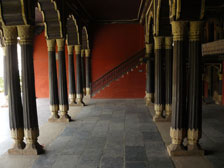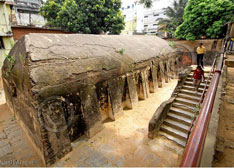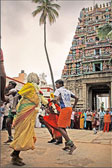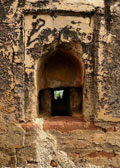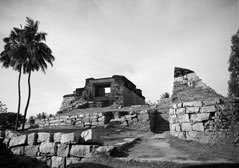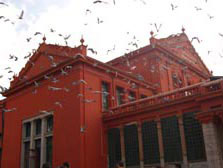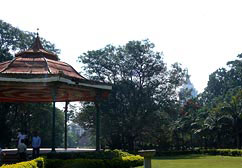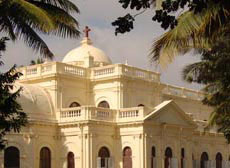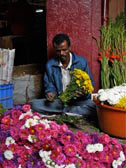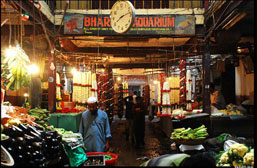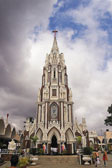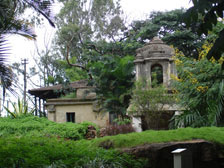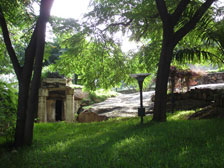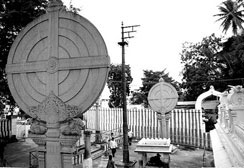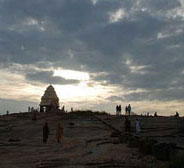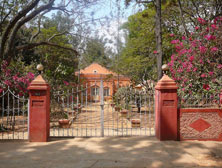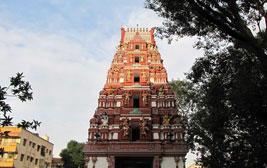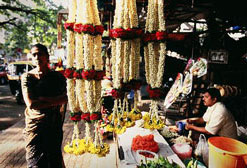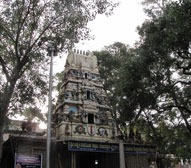Introduction
Parichay has been an incredible journey, from tentative beginnings at Begur Panchalingeshwara temple in March 2008 to a Parichay being sold out within 15 minutes of announcement. We've had at least one Parchay every month continually for the past few years. And we can't thank you enough for your generous praise and support. Some testimonials we've received:
"Wonderful experience. A new insight into my city. Loved every moment of the walk. Do conduct more of these informative walks."
- MS Lokesh, software engineer
"I've been enjoying the INTACH walks that I've been on...hope to join in when I return to Bangalore."
- Deepa Mohan, journalist, Citizen Matters
(currently on leave in the US)
"It was a Saturday morning well spent. Many thanks for organizing this."
- Vrinda, architect
"Great experience. Looking forward to many more of these"
- Divya Jayaram, student
"As always, INTACH walks rock!"
- Joy Ghosh, software engineer
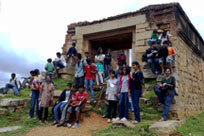
Photo: Meera Iyer
Children from Poorna school at Devanahalli
Some of our walks have been conducted in association with like-minded organisations including the National Gallery of Modern Art, Archaeological Survey of India and Bangalore City Project with Max Mueller Bhavan.
Do get in touch with us if you would like to join any of our future Parichay events. We also take school groups (see this for example, or the photo on the right) to some of these historic places. Contact us if you would like to know more.
Our walks as a travel app
With the launch of the app on iOS and Android platforms, we hope to make our walks accessible to a wider audience. Currently available in English and Kannada, the app helps you explore Bangalore Fort, Tipu's armoury, Tipu's palace and the neighbourhood. It is custom developed for INTACH Bangalore by Sonata Software Ltd as part of its corporate sustainability initiative.
Next up – the Cantonment walk that leads you through St Mark's Cathedral, Cubbon Park and Vidhana Soudha. It will be available as a free app on Android platform. IOS and Windows versions to follow.
Fraser Town Parichay
Stroll along Promenade Road and listen to Krupa Rajangam unravel the transformation of Mootoocherry, once a poor man's neighbourhood to the gentrified Fraser Town. Wander into the many churches in this neighbourhood and hear about the contributions that Catholic and Protestant missionaries made, and still make, to our beautiful city.
Ramzan Food Parichay
Our walk takes us along Mosque road and MM road to experience street food of a special kind. Join us to explore the culinary and other traditions of the holy month of Ramzan. Discover the traditional way the fast is broken, listen to stories of longtime residents, learn about the meaning of the festival and why it is celebrated and of course, sample some of the delicacies that are made especially for Ramzan.
Architecture in Cubbon Park Parichay
If you've ever wondered about architectural elements, planning or symmetry, or about Victorian, Colonial, Gothic or some equally mystifying architectural style, then this Parichay is for you. We walk through Cubbon Park and look at some of its buildings through an architect's eye as conservation architect Pankaj Modi talks about materials used, construction technology, design inspirations and more. This Parichay is open to all, especially laypersons and is not meant for architecture students!
Vintage Cars Parichay
Where can you see the world's first motor car, the Benz Patent Motorwagen? A: In Bangalore! Enthusiastically coordinated by INTACHer Aravind Chandramohan, our in house motorphile, this Parichay marked World Automobile Day on January 29th. Bangalorean and vintage car collector Dr Ravi Prakash kindly agreed to throw open the doors to his amazing collection. Among the gems in his remarkable collection are one of the world's few surviving Benz Patent Motorwagens, cars once owned by Kuvempu and royalty and other dignitaries from around the country. As also examples of different modes of transport from days long gone, including palanquins.
Temples of Avenue Road
Join us as we walk down the oldest street in the city of Bangalore to visit the plethora of shrines on and just off this road. Listen to walk leader, archaeologist Lathashree Kolla talk about local and folk deities, medieval town planning, village goddesses and more.
Hampi Parichay
One of the most fascinating and legendary places in Karnataka, Hampi is a perennial favourite and reruns each time on popular demand. UNESCO describes this World Heritage Site as austere and grandiose, where fabulously rich princes built temples and palaces that won the admiration of foreign travellers between the 14th and 16th centuries. And then in 1565, the Vijayanagara empire here was vanquished, the affluent city plundered and pillaged, never to be settled again. Explore the ruins of Hampi over two days – the architecture with its meticulous urban planning, the dynasties and political play in medieval South India among other riveting history.
Begur

Photo: Meera Iyer
Begur's 9th century Panchalingeshwara temple

Photo: Meera Iyer
Begur's 9th century Panchalingeshwara temple
Our very first Parichay took place at the Begur Temple, chosen for its very special association with Bangalore - this is where a 9th century inscription was found which first makes mention of the name Bengaluru. Our Begur Parichay usually begins with a talk by INTACH member Prof R Jegannathan on energy in Indian architecture. We then explore the Panchalingeshwara temple, and then visit the village's tiny fort and remains of an old Jain temple.
Bangalore Fort and Vicinity

Photo: Meera Iyer
At the Bangalore Fort
Our Parichays to the Bangalore Fort and its vicinity have been led by Dr SK Aruni, Assistant Director, Southern Regional Centre, Indian Council for Historical Research. One of these events was conducted as part of the celebration of World Heritage Day on April 18, 2009, when the focus of our events was the Bangalore Fort.
With maps, photographs and his in-depth knowledge of the area, Dr Aruni unfailingly brings alive the history of Bangalore as he takes the group around the Bangalore Fort, Tipu Sultan's Summer Palace and the 16th century Kote Venkataramanaswamy temple adjacent to the Palace. Participants also walk over to the Tipu Armoury behind Bangalore Medial College, and learn about Intach's previous restoration work here and its efforts to save it.
Ulsoor
Our Ulsoor walks are usually led by our convenor Sathya Prakash Varanashi. We begin by exploring the 10th century Someshwara Temple, its architecture and iconography. That done, we explore the Ulsoor settlement, the bustling Halasur Market, the old clock tower (now being replaced by a public toilet) and check out some old houses as Sathya gives us gyan on British influences here and about urban changes.
Sultanpet and Nandi

Photo: Meera Iyer
9th century Arunachalesvara temple in Nandi village
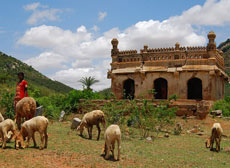
Photo: Meera Iyer
Tipu Sultan's mosque, Sultanpet

Photo: Meera Iyer
British-period cemetery
Our Parichay to the villages of Sultanpet and Nandi, near the international airport at Devanahalli, introduces the participants to the impressive 9th century Bhoganandisvara temple, before taking them to a beautiful but abandoned mosque commissioned by Tipu Sultan, and ending at a 200-year-old cemetery nearby which dates from the British period. So within the span of three hours and a couple of kilometres, you will get to see architectural styles spanning the 9th century to 19th century!
Devanahalli

Photo: Meera Iyer
At Devanahalli fort
Did you know that Tipu Sultan was born at Devanahalli? Our Parichays look at the fort through the lens of 18th century military architecture. We also talk about some of the more dramatic episodes in the fort's colourful history, including stories of sacrifice and hostage-taking. We also walk through the town, learning of vernacular architecture along the way, stop by at the 16th century Venugopalaswamy temple here, and time permitting, also visit the school of sculpture in the town.
Avenue Road

Photo: Meera Iyer
Rice Memorial Church

Photo: Meera Iyer
A trader addressing the group during a Parichay
Our Parichay to historic Avenue Road was conducted jointly with Environment Support Group and the Avenue Road Traders Association. Divya Ravindranath from ESG, and Hari Ram and Dilip Shah of the Traders Association spoke to the assembled group about the city government's proposed road-widening project. Prof Sathya Prakash Varanashi led the group through the history of fort beginning with its setting up by Kempegowda I, highlighting how it was a good example of pre-British town-planning. It was also pointed out that as a founded city, Bangalore has always had a mix of cultures, beginning with when Kempegowda cleared the jungle to build his fort and invited different communities to people his new city. Highlights of this Parichay were the visit to the Chintalapalli Venkatamuniah Setty Hostel, the generous breakfast provided to the group by the Traders at the Komatipete Venkataramanaswamy temple, and the visit to the Mishrilal Indramal shop, an almost hundred year old construction. This building had a shop in the front with a residence upstairs which in the past was home to a family of eighteen members.
Cubbon Park and the Cantonment
This Parichay was organised together Bangalore City Project. The walk explored the idea of the two cities of Bangalore - the pete and the cantonment. The event began at St Mark's Cathedral, where INTACH members Poornima Dasarathi and Meera Iyer described the history of the church, the establishment of the Cantonment, and the many contributions the church has made over the years to Bangalore. The group then walked through Cubbon Park via the Victoria Statue and down to the Bandstand. Here we had a 10 min skit on the idea of two cities that become one, courtesy MPSR Foundation. The walk also took in the Attara Kutcheri, Seshadri Iyer Hall, the Chamaraja Wodeyar Statue and finally the Government Museum.
Shivajinagar
The teeming, bustling, ever-lively area that we know as Shivajinagar was once known as Blackpully. Walk leaders Pankaj Modi and Krupa Rajangam outlined some of the stories on how Blackpully got its name on this Parichay through one of the oldest commercial areas in the city. The walk began at Adams Square and then proceeded to one of the oldest extant buildings in the cantonment, the Mohammed Ali Hall built in 1824, which is actually a beautifully decorated mews - a building used with stabling for horses and carriages below and living quarters upstairs. They also visited the Bhoopalam Subba Chetty Choultry, which has been in the same family of Bhoopalam Chetty, for more than a hundred years, Russell Market, and finally, Bangalore's oldest church, the St Mary's Basilica.
Gavipuram
Gavipuram is an old vernacular settlement in the heart of Bangalore, named after the historic Gavi Gangadhareshwara temple. Walk participants will learn about the possible astronomical significance of the famous monoliths in front of the temple. They will also visit one of the iconic Kempegowda Towers nearby, the temple priests' settlement or Agrahara and Hariharagudda, the hill behind the temple that is dotted with various mantapas.
Lalbagh

Photo: Meera Iyer
Silk Cotton Tree, Lalbagh

Photo: Meera Iyer
Lalbagh was established in 1760 by Hyder Ali as a formal garden with avenues of cypress trees separating plots of various fruit trees, shrubs and herbs. Tipu made several additions to it as did the British who expanded the garden and converted it into a botanical and zoological garden. They also added the Glass House, a bandstand and other structures. One of Kempegowda's Towers stands on the famous rock in Lalbagh, itself a National geological Monument.
Whitefield
Whitefield was set up as an Anglo-Indian and Eurasian Settlement by the Eurasian and Anglo-Indian Association of Mysore and Coorg in 1882 on 3900 acres of land granted by Mysore State. The settlement was planned as a perfect circle with a central open area surrounded by houses similar to the colonial bungalows of the Cantonment though smaller. The site is one of very few planned Anglo-Indian settlements in India. The Parichay here will begin at the Church and proceed around the circular settlement before going on to the Our Lady of Lourdes Church and Kaolin Hill.
Malleswaram
One of Bangalore's oldest and most charming neighbourhoods, Malleswaram was home to several cultural icons of Karnataka. Walk participants will learn a little about Venkatappa, Veena Doraiswamy Iyengar, Krishnawamy, G. P. Rajaratnam and T.A.S. Mani, all of whom lived here. They will also visit some of its many religious centers including the St. Peters Seminary and the historic Kaadu Malleswara temple and the Nandiswara temple.
Basavanagudi Food Walk
Conservation architect and INTACH member, Krupa Rajangam and foodie Mohan Narayan, led a group of people on a food Parichay taking in some of the legendary family run restaurants of South Bangalore - Vidyarthi Bhavan, Mahalakshmi Tiffin Rooms, Brahmins Coffee Bar, New Modern Hotel and Janata Tiffin Rooms. The walk sought to clearly show the link between cuisine and culture. All these eateries were the haunts of prominent writers, artists, poets, intellectuals and philosophers of the early and mid 1900s who held lively debates here over bracing cups of filter coffee, melt in the mouth idllis or dosas slathered with butter. As walk resource person, Katte Ramachandra (noted filmmaker) related to the group, "These were literally the places where Sahitya grew and developed." Restaurant owners spoke about how the regulars constantly wish to have nothing change - neither the food nor the ambience. Overall the Parichay was a success as both owners and the walk group were happy to have the spotlight on the history and traditions behind the restaurants and not simply the food.
Kudlu - on the trail of lakes/tanks
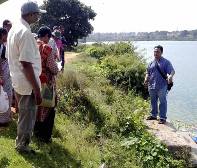
Photo: Meera Iyer
Rohan D'Souza at the sluice gate at Kudlu
INTACH's Parichay at was led by Rohan DSouza, a researcher at National Institute of Advanced Studies (NIAS). Rohan gave the group a brief introduction about Bangalore's lakes. Or tanks, to be precise. Hundreds of tanks were built to harness water in Bangalore's three valleys, some as early as the 9th century.
At our first pause point, an overflow weir (now defunct) on the tank bund, Rohan talked about how tanks systems were organised into a hierarchy. Each tank's overflow entered another tank downstream. The group also saw the old sluice gate through which water was once released into the agricultural lands adjacent to the tank. Rohan spoke about the Neergunte community who were responsible for maintaining the canals and sluices, in return for which they were given tax-free lands (inam lands). This well-oiled system broke down gradually, beginning first with the abolition of the inam system. With urbanisation came further changes. From being an integral part of the social, cultural and economic lives of the communities around them, tanks are now seen as water bodies that need to be protected as pristine oases of nature.
Rohan's talk engendered lively discussion among the Parichay folks. People spoke about the need to think creatively to re-establish connections between Bangaloreans and their tanks, about their experiences of working on management plans for some tanks, about water harvesting...
All in all, it was an eye-opening Parichay on land-water connections and the impact on tanks of the social change Bangalore is undergoing.
Tree Walk

Photo: Meera Iyer
S Karthikeyan, Chief Naturalist of Jungle Lodges and Resorts with walk participants
We're building our natural heritage portfolio - our most recent one was in Cubbon Park.
INTACH Bangalore's Tree Parichay began with a butterfly hanging onto the walk leader's thumb! From this unusual but completely appropriate start right to the very end, walk leader S Karthikeyan, had the participants in the Tree walk hanging on to his every word as they meandered through the lovely Lalbagh Botanical Gardens on a pleasant Sunday morning. Karthik is the Chief Naturalist of Jungle Lodges and Resorts and has over 20 years experience of watching nature closely. He pointed out the interdependence of species in nature like the fig-fig wasps symbiosis, or how butterflies are very finicky indeed about which species they lay their eggs on. The Parichay group learned about the talipot palm, raintrees, sheesham, elephant apples, figs, and many many more trees. They also learned about the life trees support, whether it is jumping spiders, weaver ants, parakeets or spotted owlets. One participant remarked how though she had often visited Lalbagh, she had never really looked at the trees before. Now that she had, "It's beautiful," she said!
ICKPAC (INTACH Chitrakala Parishath Art Conservation Centre)

Photo: Meera Iyer
Ms Madhu Rani, Director, ICKPAC at the Art Conservation Centre
KP Madhu Rani, Director, ICKPAC, took us on a truly fascinating journey through the world of art conservation. A mixed bunch of writers, artists, finance analysts and other assorted heritage enthusiasts hung to her every word as Madhu first led us on an eye-opening walk through the vast galleries of the Chitrakala Parishath. This was followed by a short talk which wowed everyone as she spoke about the kinds of work the conservation centre handles. Madhu and her team then showed us some of the conservation projects they were currently working on, including restoration and conservation of paintings, manuscripts and documents. Finally, the most anticipated part of the Parichay were when participants showed Madhu some of their precious heirlooms - including books, photos, spectacles, and other assorted objects - and had expert opinion on how best to conserve art and antique objects. It was, as one participant aptly described it, "a fascinating Parichay".
Melkote, Mandya District

Photo: Ayan Ghosh
Gathering at the Rayagopura
These 'out of Bangalore' day long heritage trawls are just the beginning - we hope to add more within Karnataka as we go along.
To celebrate World Heritage Week, INTACH Bangalore organised a one-day Parichay at Melukote, on Sunday, 21st November 2010, an event made possible with the generous support of ASI, Bangalore Circle.
The walk was led by Chapter Convenor, Prof Sathya Prakash Varanashi, who introduced Melukote, its layered history, and its unique blend of religion, spirituality, literature, culture, cuisine and craft. Supporting him were Dr Meera Iyer, researcher, writer and Co-Convenor, INTACH Bangalore and writer, social activist and longtime resident of Melukote, Santosh Koulagi associated with the NGO, Hosa Jeevana Daari (HJD).
Melukote is intimately linked with the Vaishnava saint Ramanujam, who is said to have taken refuge here over 800 years ago. It's central monument is the 12th century Cheluvanarayaswamy temple, an ASI protected structure. Its second most important shrine is the Yoganarasimha temple which overlooks the town from a hill. The group first visited these temples, and some of Melkote's many tanks, which are also essential components of the town's historic persona. Lunch was a heritage highlight too - a delicious, traditional Melukote Iyengar meal set in the midst of the organic farm and weaving centre run by HJD. Post lunch, the group visited the Rayagopura, the town's old colossal, unfinished gateway, and then a weaver's home, where Mr Koulagi spoke about Melukote's dying weaving tradition - once home to 300 pitlooms producing quality silk, now dwindled to a mere 20. The trip concluded with refreshments at a 100-year-old ancestral house that belongs to Mr Koulagi's parents.
The trip brought home the reality of fast disappearing culture clusters and the need to evolve a heritage management plan involving all stakeholders to protect the precious little that survives.
Srirangapatna, Mysore District

Photo: Meera Iyer
Engrossed in a game designed around Tipu Sulltan and his capital city!
These 'out of Bangalore' day long heritage trawls are just the beginning - we hope to add more within Karnataka as we go along.
An excited group of about 15 people piled into a bus one morning in March to attend INTACH Bangalore's day-long heritage tour to the historic city of Srirangapatna, capital of Tipu Sultan, Hyder Ali and the Wodeyars before that. The tour, led by Co-Convenor Meera Iyer and member Poornima Dasharathi, started off with an ice-breaker round of introductions on the bus that also served to give people a background to the city. At Srirangapatna, the group retraced and relived the events of that fateful day in 1799 when Tipu Sultan was killed at the fort. After visiting parts of the fort where pitched battles had once been fought, the group visited the famous and ancient Ranganathaswamy temple on the island, before sitting down to a leisurely lunch on the banks of the Cauvery. A fun round of games followed, to help the group revive, after which they visited Tipu's mausoleum and the beautiful Daria Daulat palace. "Great! Got to know so many unknown aspects of Srirangapatna," said one participant as she and many others asked for more such daylong tours to be organised by the Chapter.


